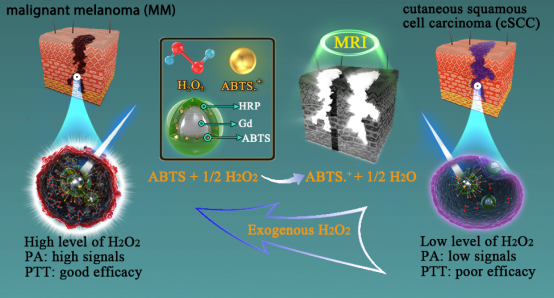Cutaneous squamous
cell carcinoma and malignant melanoma are two most typical malignant tumors in
dermatology, of which the latter one has a lower incidence but higher
malignancy. These cutaneous tumors usually occur at exposed skin, which usually
requires non-invasive diagnosis and therapy, whereas conventional pathological
diagnosis and surgical therapy are both invasive. With improvement of people's
living standards, the need of an integrated and intelligent solution to
non-invasive diagnosis and precision therapy is rising and the integration of
medicine and engineering may provide the solution.
Recently, a
research by Prof. Wang Xiuli from Shanghai Skin Disease Hospital affiliated to
Tongji University and Prof. Zhang Binbo from Tongji University School of
Medicine shows that, intelligent nanoprobes(iHRANPs)responsive to H2O2 can discriminate
tumors of different types based on the H2O2 concentration
difference inside tumors and therefore precisely guide subsequent therapy,
achieving intelligent theranostics integrating photoacoustic diagnosis and
photothermal therapy. This research was recently published in internationally
renowned journal ACS Nano.
On the basis of
previous research, Prof. Wang Xiuli and her team applied theranostics
nanoprobes to diagnosis and therapy of cutaneous squamous cell carcinoma and
melanoma. Clinically, melanoma and cutaneous squamous cell carcinoma have
different biological features, differing greatly in malignancy, which is
closely associated with tumor microenvironment. H2O2 in
tumor microenvironment are associated with occurrence, development and
metastasis of tumor so that there might be difference of H2O2
concentration in different tumors. How to conduct precision therapy that is
responsive to microenvironment? Prof. Zhang Binbo's team
synthesized a highly sensitive iHRANPs responsive to H2O2
by enzyme-mediated bionics. H2O2 triggers HRP to catalyze
oxidation of ABTS to ABTS•+ that has a strong absorption of near infrared light
and therefore the probe shows good photoacoustic and photothermal properties.

Figure 1 schematic of precision theranostics of cutaneous
tumors by iHRANPs.
Prof. Wang Xiuli's
team studied iHRANPs in cutaneous squamous cell carcinoma mice and melanoma
mice contrastively.
Results showed that after intravenous injection of iHRANPs through tail veins,
photoacoustic signal in melanoma is stronger than that in cutaneous squamous
cell carcinoma while magnetic resonance signal in both tumors increased but has
no significant difference. These results indicate that H2O2
concentration is higher in melanoma than in cutaneous squamous cell carcinoma,
as is also validated by both in vivo and in vitro quantitative test. iHRANPs
show different responsiveness to different cutaneous tumors, as is verified by
photoacoustic signals, laying the foundation of differential diagnosis of the
two tumors. Subsequent photothermal experiments showed results consistent with
above conclusion, in which tumor suppression in melanoma mice is stronger than
that in cutaneous squamous cell carcinoma mice after intravenous injection of
iHRANPs through tail veins and illumination of 808 nm light. In addition,
topical injection of H2O2 in cutaneous squamous cell
carcinoma increased photothermal tumor suppression of iHRANPs. Based on these
results, we can use iHRANPs-mediated photothermal anti-tumor effect in precise
therapy of melanoma and cutaneous squamous cell carcinoma and achieve magnetic
resonance imaging of iHRANPs. This research preliminarily practiced the concept
of non-invasive, precision therapy and integrated theranostics at the animal
level and laid the foundation for further clinical translation of intelligent
medicine.
This research
received supports from Tongji University Interdisciplinary Project of Medicine
and Engineering and National Natural Science Funds. The co-correspondence
authors are Prof. Wang Xiuli and Prof. Zhang Binbo. The co-first authors are
Dr. Wang Peiru from Department of Photomedicine Therapy, Dr. Yang Weitao and
graduate student Shen Shuzhan from Tongji University School of Medicine.
Authors:Peiru Wang#, Weitao Yang#, Shuzhan Shen#, Chao Wu, Long Wen, Qian Cheng, Bingbo Zhang* and Xiuli Wang*.
Link: Differential
Diagnosis and Precision Therapy of Two Typical Malignant Cutaneous Tumors Leveraging
Their Tumor Microenvironment: A Photomedicine Strategy.
https://pubs.acs.org/doi/pdf/10.1021/acsnano.9b04070
